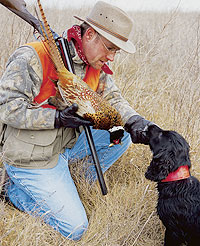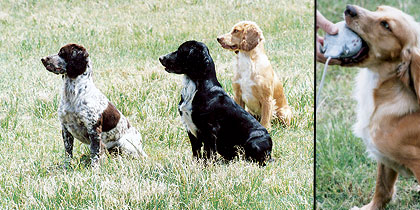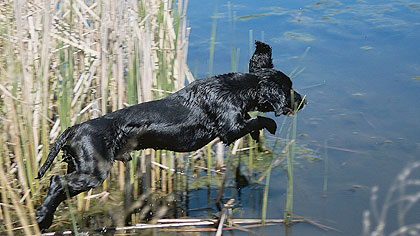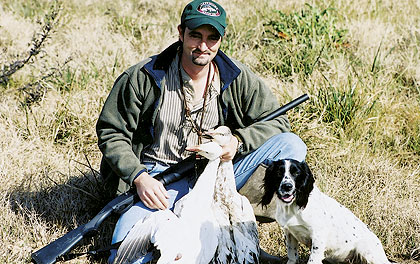The Field-Bred English Cocker
By Chad Mason
 The author congratulates his English cocker, Rascal, on a job well done. |
In North America, the adjective English conjures a vision of tweedy gentlemen with fine etiquette. This image, however, simply won't do for the field-bred English cocker spaniels I've known. The cockers of my experience are more accurately personified as amply liquored south Londoners with a heavy Cockney accent, the sort who call you "Mate" and laugh boisterously at jokes that fly past a bewildered Yank.
In order to fall in smoothly with such people, an American must invest considerable time and acquire a new sense of humor, but the resulting fun is well worth the effort. The same goes for field-bred cockers. They are a pint of stout, not a cup of tea.
Which English Cocker?
By now the observant reader will have noticed the recurring qualification: "field bred." I have thus cracked the lid on a can of worms, and might as well dump them out. There is a definite split in this breed, and space limitations compel me to focus on one side of that split. I do not mean to diminish the worth of show- or dual-type English cockers. Rather, I am both confessing my ignorance and making a judgment about which type of dog most readers of this magazine would be happiest with.
I am certainly no expert on show dogs, and will leave their discussion to people more qualified than I. (See "For More Information" at the end of this article.) My modest firsthand experience with dual-type cockers leaves me convinced that a dual-type cocker is basically a show-type cocker that can pass a "hunting test."
More worms will squirm free with my encapsulation of hunting test in quotation marks, but I'm willing to bear the scorn. I've spent a quarter century hunting eight species of upland birds and 10 species of waterfowl in wild habitats from Georgia to Alberta, and I killed those birds over nine breeds of sporting dogs representing all major categories: pointers, retrievers, spaniels and versatile breeds.
 Dell, Billy and Bud Light await commands from trainer Martin Bell, demonstrating the breed's eagerness to work. (Right) Bud Light, a honey-colored English cocker, delivers a Dokken dummy to trainer Martin Bell. |
I've also witnessed hunting tests for all these breeds conducted by several parent clubs and registries. Among the spaniel ranks, the difference between hunting tests and wild bird hunting seems analogous to the difference between passing a quiz and having a real job. I apply this critique especially to Working Dog tests (WD, WDX). "Working Dogs" are more a cup of tea than a pint of stout. If you want a dual-type cocker, stick with bloodlines having a preponderance of AKC Junior, Senior and Master Hunter suffixes (JH, SH, MH).
At the present time, I believe the cocker field trial circuit--though not perfect--is a better proving ground for hunting cockers than are hunting tests. Trials more closely simulate the demands and conditions of real hunting. And spaniel field trials are currently dominated by field-bred dogs. Good field-bred dogs are identified by pedigrees showing ancestors with "FC" pre-fixes (Field Champion).
In appearance, field-bred cockers have longer backs, tails and muzzles than show- or dual-type dogs, and their ears are shorter and higher-set. All of these characteristics are advantageous in the field. Look at the pictures in this article, and you'll see what a field-bred cocker looks like.
There. Those are the dogs I'm talking about.
Cocker History
The word spaniel reflects a probable Spanish origin for all the breeds we presently call by that name. But it was the English who perfected the flushing spaniel. Of course, you will not hear the term flusher in England. There, spaniels do not "flush" game; they "spring" it. Winston Churchill said Americans and Britons are "two great peoples separated by a common language." In this case we must tip our hats to the Brits, because their terminology really is more precise. After all, to spring something is to make it go up; to flush something is, well, to make it go down.
 Though not really suited to retrieving large waterfowl under severe conditions, English cockers are willing water workers. |
"The feasant cocke the woods doth frequent, where spaniels spring and perche him by the sent." So says a 13th century engraver who described how spaniels were used to spring pheasants onto tree limbs where they could be potted with a crossbow.
But whence came the cocker? He was the runt of a springer litter. When the old-time Brits bred a litter of spaniels, they held off classifying the dogs until full grown. The big ones they called "springers," and the wee lads they called "cockers."
How little are they? There is considerable variation among cockers. Properly proportioned dogs run anywhere from 25 to 42 pounds, while bitches run 22 to 38, although both favor the lower end of these ranges. Today the average cocker--if there is such a thing--probably weighs about 30 pounds.
The name cocker comes from the unique niche occupied by the smaller dogs. The British considered them ideal for hunting woodcock in dense thickets of gorse. Over time, dogs were bred selectively for size, producing the separate breeds we know today--the English springer spaniel and the English cocker spaniel. As we shall see, however, the English cocker is not simply a small springer. Cockers have a very distinct personality.
National field trials for cockers were held in the United States from 1925 through 1962, with some interruptions caused by World War II. However, American hunters always showed relatively minor interest in the breed, and by 1963 there weren't enough hunting-focused cocker owners to justify the running of a National Championship. Cocker field trials in America faded away altogether in the mid-1960s, while show enthusiasts remained interested in the breed.
Meanwhile, British hunters never lost their affection for the field cocker, and their field trials continued apace. When a few American hunters became interested in the breed in the late 1970s and early 1980s, they looked to the Isles for hunting stock. Many cockers
were imported from England, Scotland and Wales bearing Old World kennel names: Jordieland, Parkbreck, Nancarrow, Wernffrwd, Maesydderwen and others.
The bulk of them found new homes in Wisconsin, Michigan, Minnesota, Ohio, New York and other states where the game bag includes ruffed grouse, woodcock, pen-raised pheasants and the occasional duck. But today you'll find top-notch cocker breeders even in places that seem unlikely for the breed, places like the windswept prairies of North Dakota and the brush country of Texas.
Once trained, they stay trained with minimal brush-ups. They do, however, necessitate a particular kind of humor best honed by watching comedies on the BBC. They're highly intelligent, cooperative, affable, frequently impish, occasionally devious little dogs.
 Martin Bell and his field champion Rosie with a brace of snow geese. |
They're tough, too. There is a difference between toughness and durability. Retrievers and versatile breeds are highly durable. Spaniels, on the other hand, are tough. Toughness is what you need when you aren't very durable. In our five years together, I can count on one hand the times Rascal didn't bleed on a hunt. I believe he would hunt himself to death if I didn't stop him. Moreover, his demise would come much more quickly than that of retrievers, pointers, versatile dogs or even English springers.
The English cocker is not for everyone. Some cocker fans, out of blind love, believe their dogs are perfect for everything from capercaille to cougar. They may howl in protest, but I would never recommend a single English cocker for anyone who hunts wild birds all day long for days at a time.
| FOR MORE INFORMATION | 

For info on field trial results, links to breeders and trainers, and info on the 2006 National Cocker Championship , see www.fieldcockers.com. For info on show- and dual-type English cockers, including rules for hunting tests and schedules for other events, see the English Cocker Spaniel Club of America at www.ecsca.org. Breeders/Kennels
Martin & Shelly Bell
Shelmar Kennels
Katy, TX 77493
(281) 371-2554
www.shelmarkennels.com Mike & Rumi Schroeder
Fallen Wings Kennel
Hilbert, WI
(920) 853-3041
Website
|
|
One cocker suffices for a day, two for a weekend. They hunt with such drive that I must rotate Rascal and Sanka in half-day shifts. Although both are in prime physical condition, they can take two days of this rotation before they need a day to recuperate. But frankly, I need a break after a couple days, too.
Martin Bell is an avid waterfowler, and his cockers pick up hundreds of ducks and geese every year. Nevertheless, I believe the breed is best suited to the primarily upland hunter who hunts waterfowl occasionally. However, if your main birds are bobwhites, Huns, prairie chickens or sharptail grouse in expansive, homogenous country, I believe you're better served by a dog that covers more ground (i.e., a pointing dog).
An English cocker is also probably not the best choice for an older hunter with bad knees and extra pounds. Their rapid, scurrying style of hunting, and their attention-demanding personality will wear you down if you're the quiet, slow-moving type.
Ultimately, you buy a cocker because of something you love about that wry personality of theirs. Martin Bell says that sometimes when he is handling one of his cockers in the field, the dog looks at him as if to say, "You poor fellow; you really don't know what you're doing, do you?" I told Bell that I thought the ideal field-bred English cocker owner was an avid bird hunter in good physical shape, with a somewhat intense personality and an ironic sense of humor. He chuckled and said, "Right on, Mate!"
Chad Mason's highly acclaimed collection of bird hunting essays, Voices On The Wind, is available from Countrysport Press. 800-766-1670, www.countrysportpress.com.






